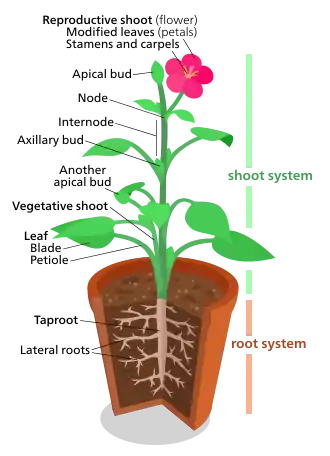| This article is part of a series on the |
| Development of organ systems |
|---|
An organ system is a biological system consisting of a group of organs that work together to perform one or more functions.[1] Each organ has a specialized role in a plant or animal body, and is made up of distinct tissues.
Animals
Other animals have similar organ systems to humans although simpler animals may have fewer organs in an organ system or even fewer organ systems.
Humans

There are 11 distinct organ systems in human beings,[2] which form the basis of human anatomy and physiology. The 11 organ systems: the respiratory system, digestive and excretory system, circulatory system, urinary system, integumentary system, skeletal system, muscular system, endocrine system, lymphatic system, nervous system, and reproductive system. There are other systems in the body that are not organ systems—for example, the immune system protects the organism from infection, but it is not an organ system since it is not composed of organs. Some organs are in more than one system—for example, the nose is in the respiratory system and also serves as a sensory organ in the nervous system; the testes and ovaries are both part of the reproductive and endocrine systems.
| Organ system | Description | Component organs |
|---|---|---|
| Respiratory system | breathing: exchange of oxygen and carbon dioxide | nose, mouth, paranasal sinuses, pharynx, larynx, trachea, bronchi, lungs and thoracic diaphragm |
| Digestive and excretory system | digestion: breakdown and absorption of nutrients, excretion of solid wastes | teeth, tongue, salivary glands, esophagus, stomach, liver, gallbladder, pancreas, small intestine, large intestine, rectum and anus |
| Circulatory system | circulate blood in order to transport nutrients, waste, hormones, O2, CO2, and aid in maintaining pH and temperature | blood, heart, arteries, veins, capillaries |
| Urinary system | maintain fluid and electrolyte balance, purify blood and excrete liquid waste (urine) | kidneys, ureters, bladder and urethra |
| Integumentary system | exterior protection of body and thermal regulation | skin, hair, exocrine glands, fat, and nails |
| Skeletal system | structural support and protection, production of blood cells | bones, cartilage, ligaments and tendons |
| Muscular system | movement of body, production of heat | skeletal muscles, smooth muscles and cardiac muscle |
| Endocrine system | communication within the body using hormones made by endocrine glands | hypothalamus, pituitary, pineal gland, thyroid, parathyroid and adrenal glands, ovaries, testicles |
| Lymphatic system | return lymph to the bloodstream, aid immune responses, form white blood cells | lymph, lymph nodes, lymph vessels, tonsils, spleen, thymus |
| Nervous system | sensing and processing information, controlling body activities | brain, spinal cord, nerves, sensory organs and the following sensory systems (nervous subsystems): visual system, Olfactory system, taste (gustatory system), hearing (auditory system) |
| Reproductive system | sex organs involved in reproduction | ovaries, fallopian tubes, uterus, vagina, vulva, mammary glands, penis, testicles, vas deferens, seminal vesicles and prostate |
Plants

Plants have two major organs systems. Vascular plants have two distinct organ systems: a shoot system, and a root system. The shoot system consists stems, leaves, and the reproductive parts of the plant (flowers and fruits). The shoot system generally grows above ground, where it absorbs the light needed for photosynthesis. The root system, which supports the plants and absorbs water and minerals, is usually underground.[3]
| Organ system | Description | Component organs |
|---|---|---|
| Root system | anchors plants into place, absorbs water and minerals, and stores carbohydrates | roots |
| Shoot system | stem for holding and orienting leaves to the sun as well as transporting materials between roots and leaves, leaves for photosynthesis, and flowers for reproduction | stem, leaves, and flowers |
See also
References
- ↑ Betts, J Gordon; et al. (2013). 1.2 Structural Organization of the Human Body - Anatomy and Physiology. Openstax. ISBN 978-1-947172-04-3. Archived from the original on 2023-03-24. Retrieved 14 May 2023.
- ↑ Wakim, Suzanne; Grewal, Mandeep (August 8, 2020). "Human Organs and Organ Systems". Archived from the original on November 24, 2020. Retrieved October 7, 2020.
- ↑ Hillis, David M.; Sadava, David; Hill, Richard W.; Price, Mary V. (2014). "The plant body". Principles of Life (2nd ed.). Sunderland, Mass.: Sinauer Associates. pp. 521–536. ISBN 978-1464175121.